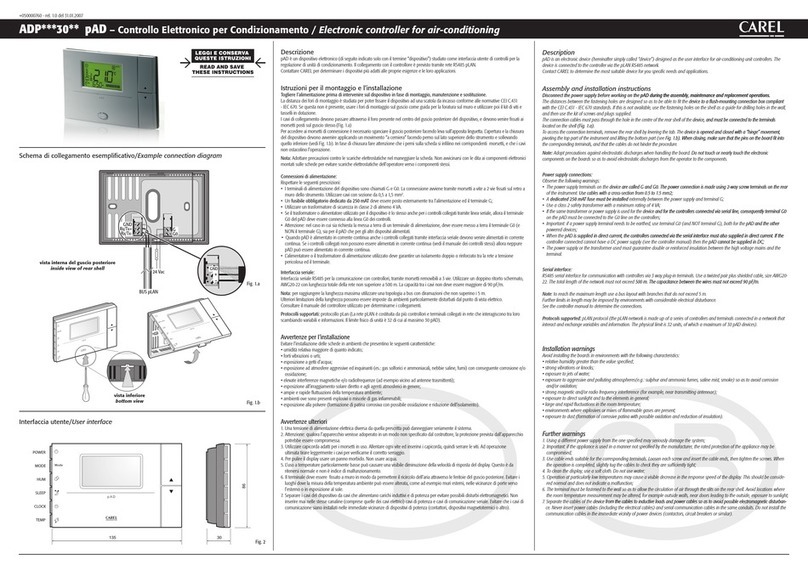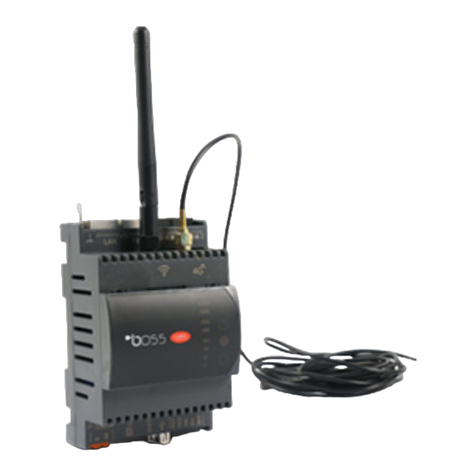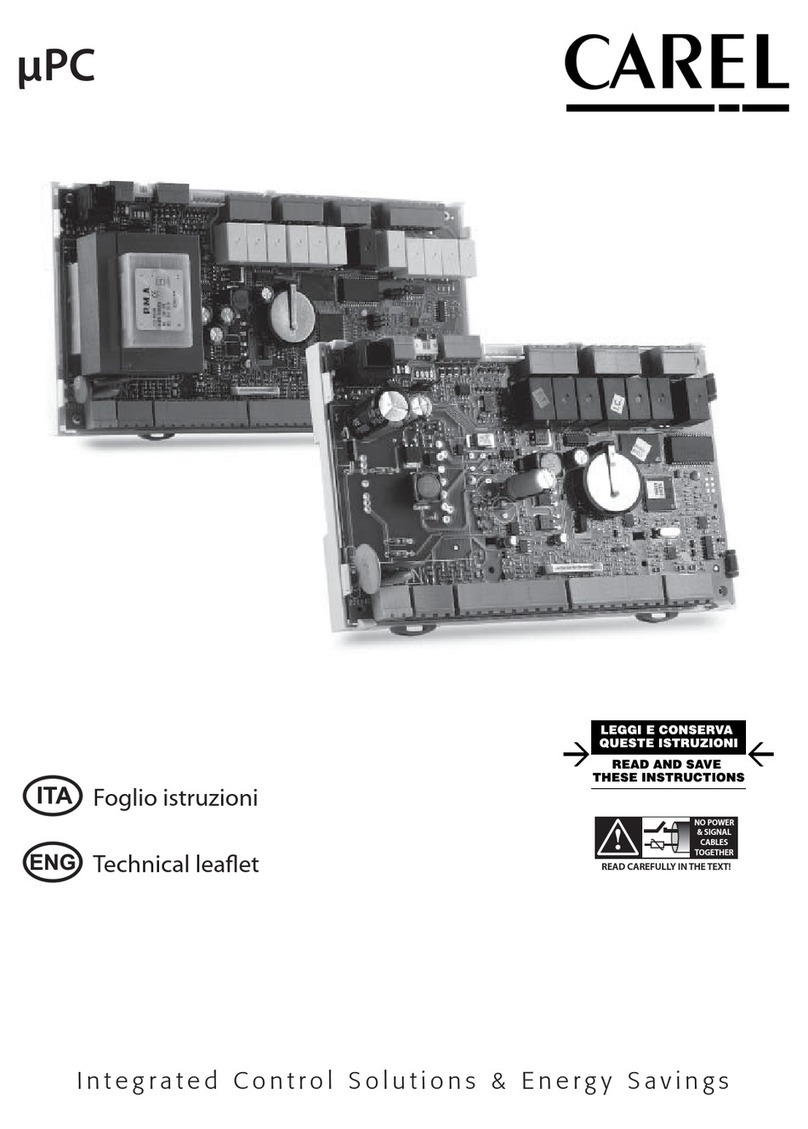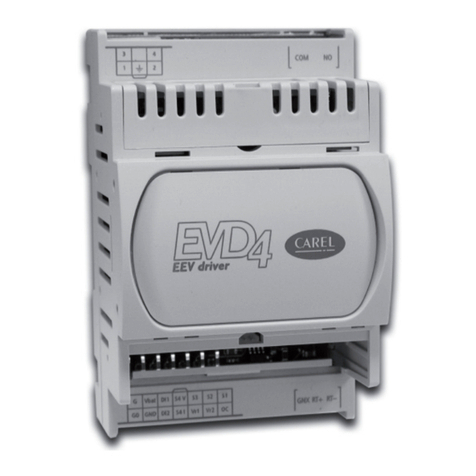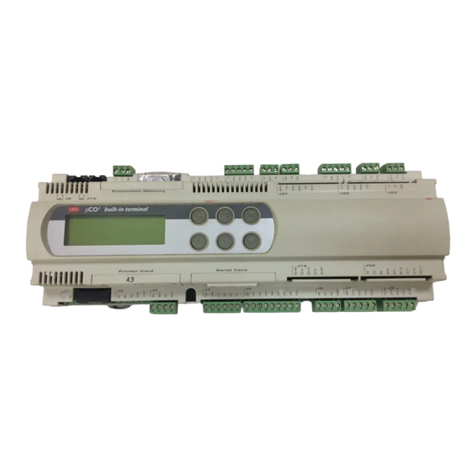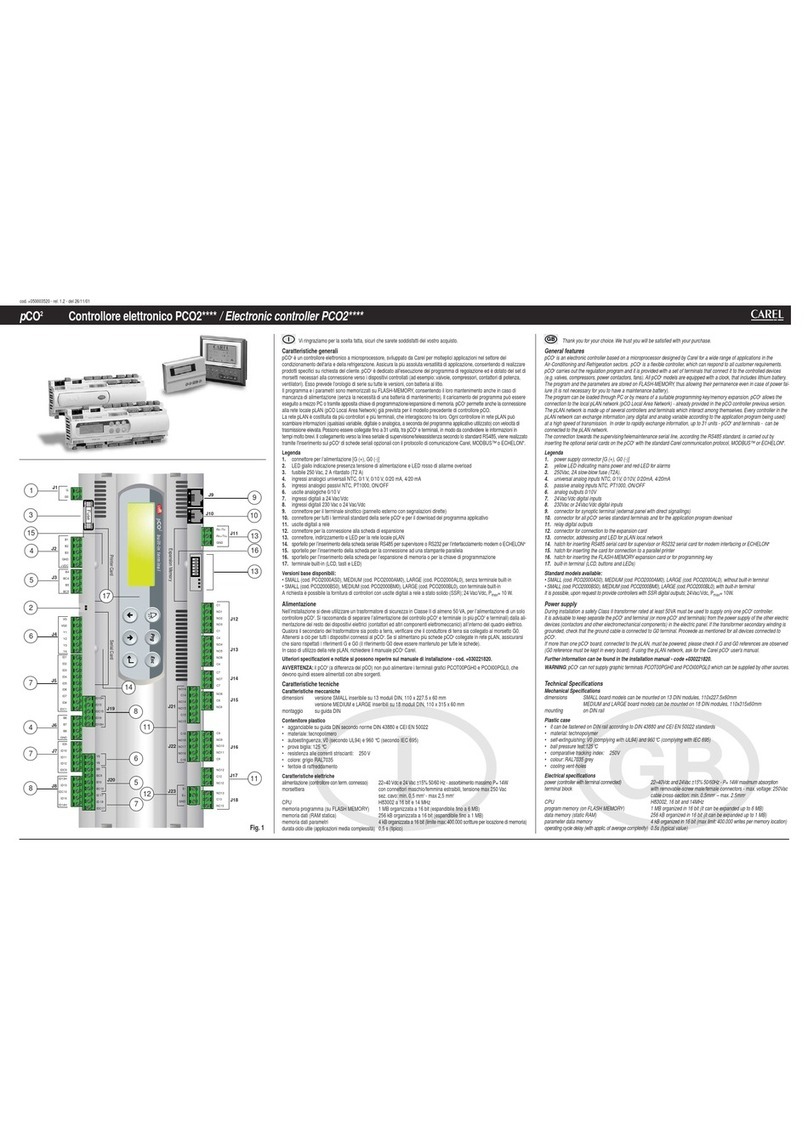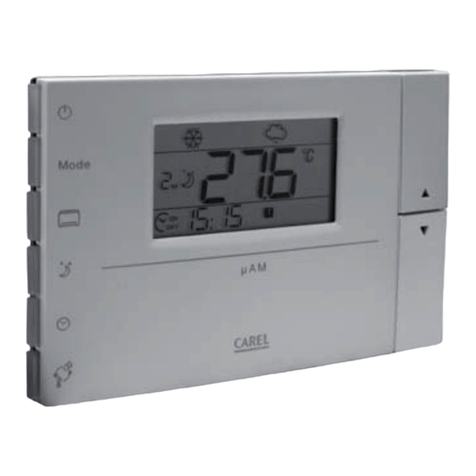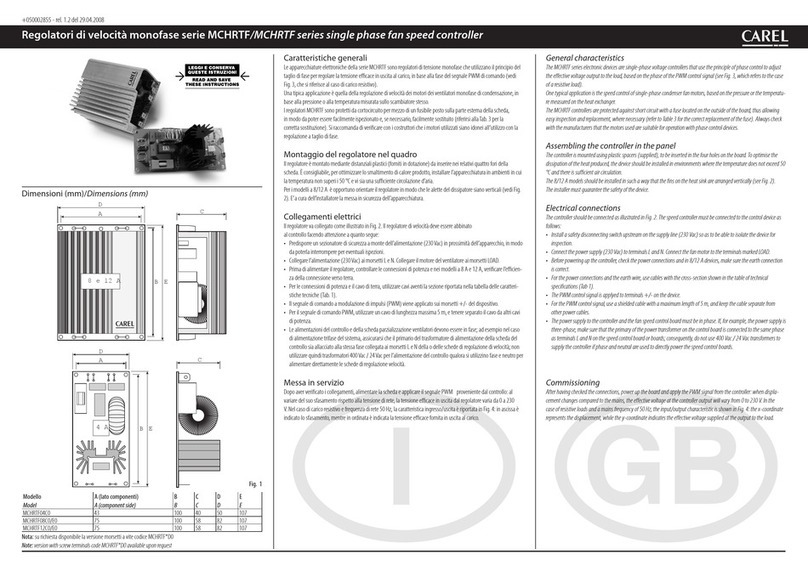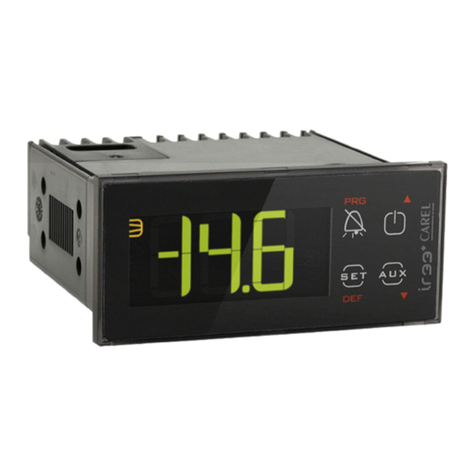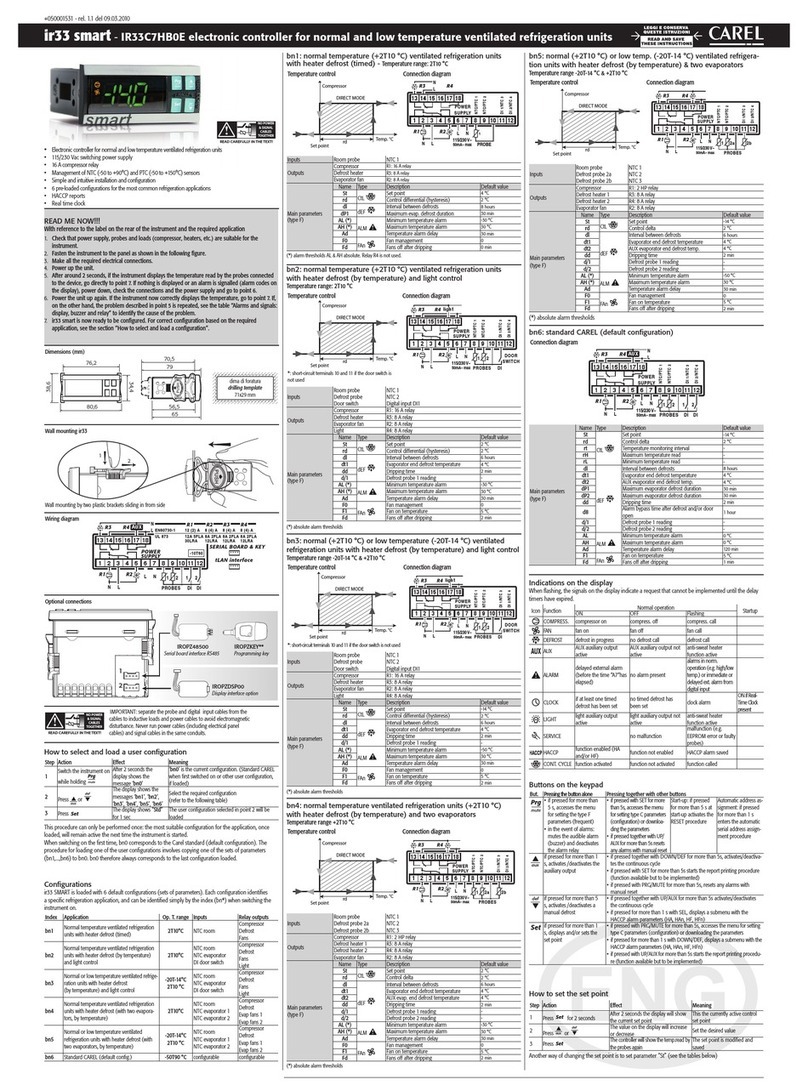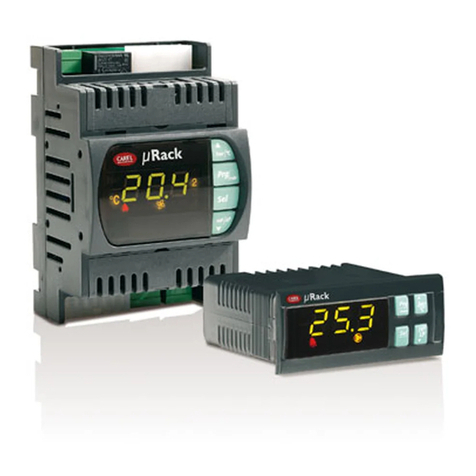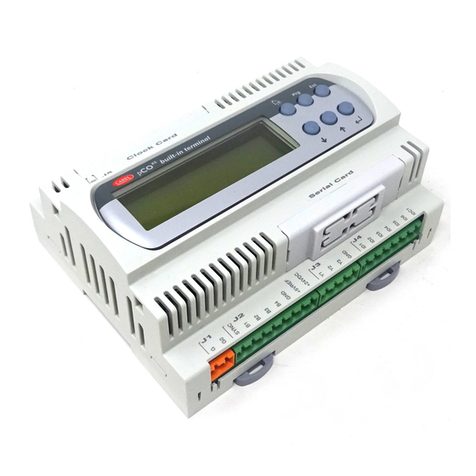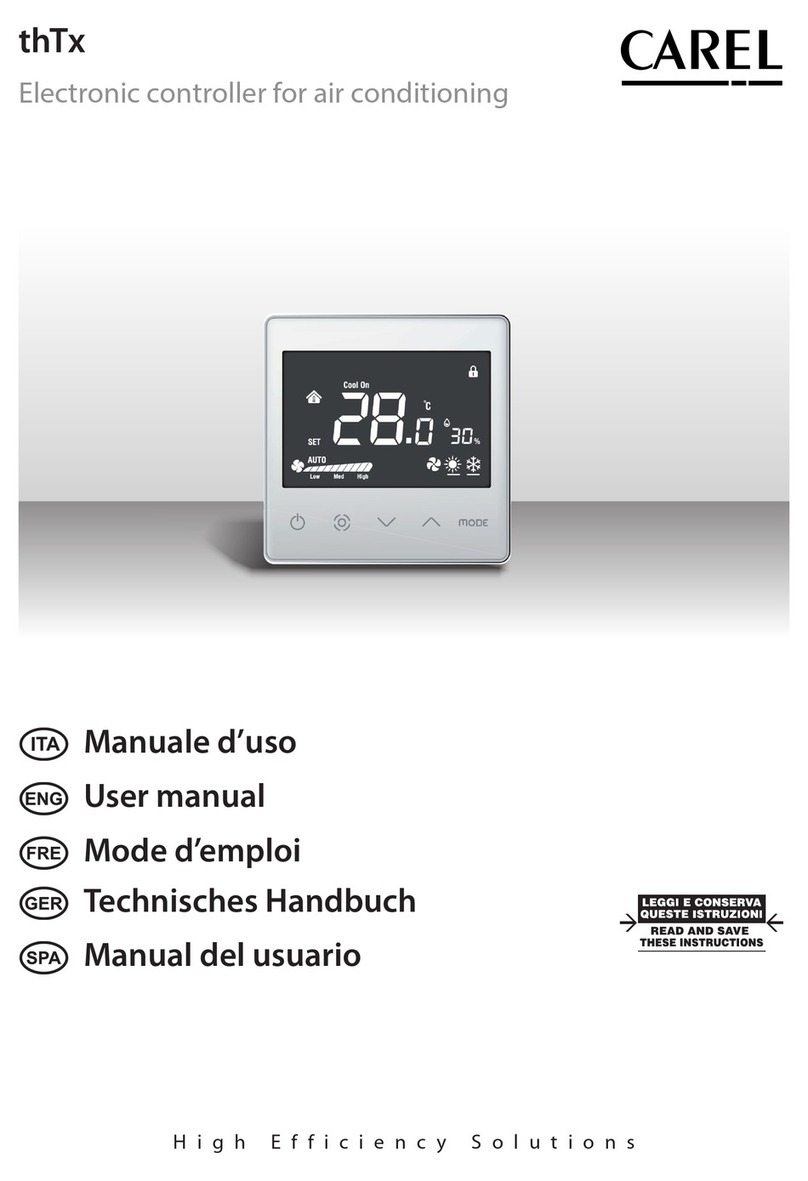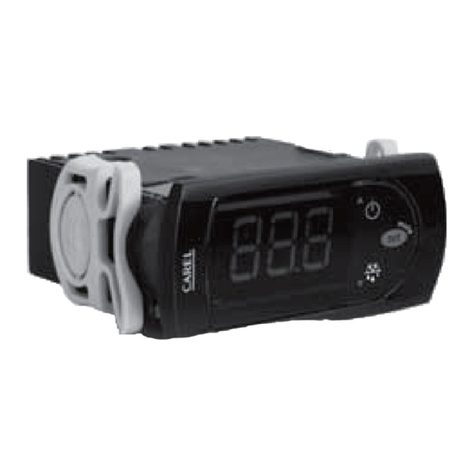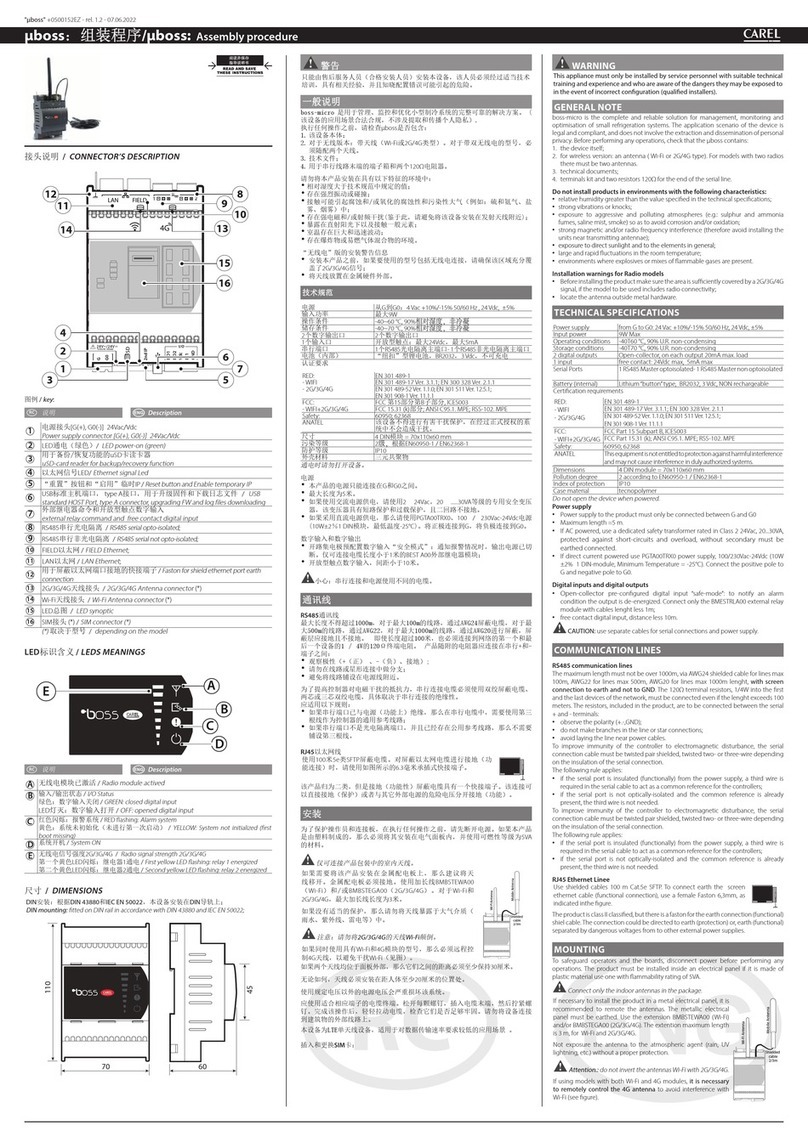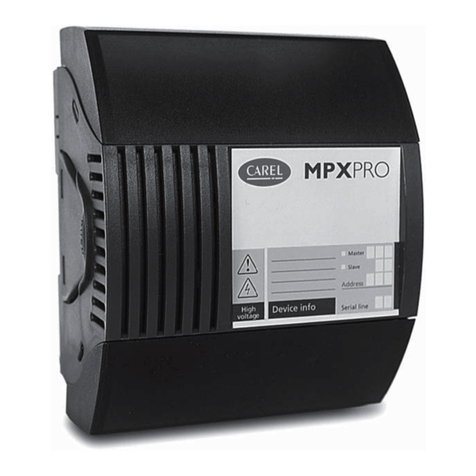
c.pCOMini é un controllo elettronico programmabile sviluppato da Carel per ap-
plicazioni di condizionamento, riscaldamento e refrigerazione e in generale del
settore HVAC/R. Assicura una notevole essibilità, consentendo di realizzare so-
luzioni speciche su richiesta del cliente. Attraverso l’utilizzo del software c.Suite
sviluppato da Carel per i controlli programmabili assicura la massima essibilità di
programmazione adattabile per ogni esigenza.
c.pCOMini controlla la logica ingressi/uscite, la comunicazione con il terminale
della famiglia pGD1, oltre alla comunicazione con altri dispositivi grazie alla pre-
senza di tre porte seriali, una porta Canbus e una porta Ethernet.
Gli ingressi/uscite universali (denominati nello schema di connessione come U)
possono essere congurati da programma applicativo per collegare sonde attive
e passive, ingressi digitali, uscite analogiche e PWM. Ciò aumenta la possibilità
di congurazione degli ingressi/uscite, aumentando la essibilità di utilizzo dello
stesso controllo per diverse applicazioni.
L’utilizzo del software c.Suite, installabile su PC, per la creazione e la personalizza-
zione del programma applicativo, la simulazione, la supervisione e la denizione
dell’intelligenza distribuita, permette di sviluppare nuove applicazioni in breve
tempo. Il caricamento del software applicativo sul controllo tramite porta USB o
Ethernet avviene tramite il programma c.Factory.
La gamma c.pCOMini è composta dai modelli DIN (con o senza display LCD), e dal
modello a pannello. Entrambi i modelli si dividono in 3 versioni (Basic, Enhanced e
High-End) in funzione della connettività e degli I/O a bordo (vedi Tab. 1).
CARATTERISTICHE DEGLI I/O
Ingressi Digitali
Tipo: ingressi digitali a contatto pulito
Numero di ingressi digitali (DI): 2
Massima corrente in uscita: 5mA
Massima tensione a contatto aperto: 12Vdc
Massima lunghezza del cavo di connessione: inferiore a 10m
Uscite analogiche
Tipo: 0...10 Vdc continui, PWM 0/10 V 100 Hz sincroni con l’alimentazione per
comando modulo taglio di fase, PWM 0/10 V frequenza 100 Hz, PWM 0/10 V
frequenza 2 KHz, selezionabili da programma applicativo
Numero di uscite analogiche (Y): 2
corrente massima in uscita: 10mA
Duty Cycle uscita PWM selezionabile da programma applicativo: range operativo
0% - 10%...90% - 100% (valori nel range 1..9% - 91..99% non sono gestiti).
Precisione delle uscite analogiche: ± 3% del fondo scala
Massima lunghezza del cavo di connessione: inferiore a 10m
Canali Universali
Bit conversione analogico digitale: 14
Tipo di ingresso selezionabile da applicativo: NTC, PT1000, PT500, PT100, 4...20mA,
0...1 V, 0...5 V, 0...10 V, Ingresso digitale da 0 a 2KHz (risoluzione ± 1Hz) di tipo
ON/OFF o di tipo open collector (Rpullup 2Kohm)
Tipo di uscita selezionabile da applicativo: PWM 0/3,3 V 100 Hz, PWM 0/3,3 V
2 KHz, uscita analogica 0...10 V Massima corrente in uscita 2 mA
Numero di canali universali (U): 10
Precisione lettura ingressi analogici: ± 0,3% del fondo scala
Precisione uscite analogiche: ± 2% del fondo scala
Massima lunghezza del cavo di connessione: inferiore a 10m
Uscite digitali
Gruppo 1 (R1, R2); Gruppo 2 (R3, R4, R5): Potenza commutabile: NO EN 60730-1: 2(1) A
(50.000 cicli); UL60730: 5A resistivi, 250Vac, 30k cicli, 105°C, Denite Purpose, 1FLA,
6LRA, 250Vac, 30k cicli, 105°C, pilot duty C300, 250Vac, 30k cicli, 105°C.
Gruppo 3 (R6): Potenza commutabile: NO EN 60730-1: 1(1) A (100.000 cicli)
Massima tensione commutabile: 250Vac; UL 60730-1: 1A resistivo, 1A FLA, 6A LRA,
250Vac, D300 pilot duty, 30.000 cicli.
Potenza commutabile R2, R5 con montaggio SSR: 15 VA 110/230 Vac o 15 VA 24
Vac secondo il modello acquistato.
Tra il Gruppo 1 e il Gruppo 2 è presente un isolamento di tipo principale. Il Gruppo
3 possiede un isolamento rinforzato rispetto agli altri due gruppi e può essere
applicata una diversa tensione di alimentazione.
Massima lunghezza del cavo di connessione: inferiore a 30m
Uscita Valvola Unipolare
Numero di valvole: 1
Massima potenza per ogni valvola: 8 W
Tipo di pilotaggio: unipolare
Connettore valvola: 6 pin sequenza ssa
Alimentazione: 13 Vdc ±5%
Corrente massima: 0.35 A per ogni avvolgimento
Minima resistenza avvolgimento: 40 Ω
Massima lunghezza cavo di connessione:
Ambiente residenziale/industriale =
2m senza cavo schermato. 6 m con utilizzo di
cavo schermato connesso a terra da entrambi i lati (E2VCABS3U0, E2VCABS6U0)
Ambiente domestico =
2m senza cavo schermato.
CARATTERISTICHE ELETTRICHE E MECCANICHE DEL CONTROLLO
Alimentazione:
Tensione di alimentazione del prodotto alimentato tra G e G0: 24 Vac +10%/-15%
50/60 Hz, 28 to 36 Vdc +10% to -15%;
Tensione di alimentazione del prodotto alimentato tra G0 e Vbat: +18Vdc unica-
mente per alimentazione proveniente da modulo ultracap (EVD0000UC0).
NB: con alimentazione Vdc non è gestita la chiusura forzata dell’ExV in caso di
mancanza tensione.
Durata minima del prodotto correttamente funzionante connesso al modulo Ultra-
cap: 60 secondi senza chiusura forzata valvola 40 secondi con chiusura forzata valvola
Massima Potenza assorbita: 30 VA /12W (40 VA in caso di alimentazione combi-
nata con modulo Ultracap). Isolamento tra alimentazione principale e controllo
di tipo rinforzato garantito dal trasformatore di alimentazione con isolamento di
sicurezza (IEC61558-2-6).
Protezione da cortocircuito: fusibile esterno da 2,5AT (IEC60127-1).
Massima tensione connettori (NO1…C6): 250 Vac;
Sezioni minime dei conduttori uscite digitali: 1,5 mm2
Sezioni minime dei conduttori di tutti gli altri connettori: 0,5 mm2
ATTENZIONE: Utilizzare un trasformatore con collegamento di G0 a terra
obbligatorio nella versione di prodotto con porta di comunicazione ETHERNET.
L’alimentazione del prodotto si deve eettuare unicamente tra G e G0.
Il morsetto Vbat è utilizzato unicamente per la connessione con il modulo
ultracap come alimentazione di backup in caso di mancanza di alimentazione
Alimentazioni fornite dal prodotto
Tipo: +Vdc per alimentazione sonde esterne, +5 Vref per alimentazione sonde
esterne; +Vterm per alimentazione terminali
Tensione nominale +Vdc: 12 Vdc ±8%
Max corrente disponibile +Vdc: 50 mA, protetta da cortocircuito
Tensione nominale +5Vref: 5 Vdc ±3%
Massima corrente disponibile (+5 Vref): 50 mA, protetta da cortocircuito
Tensione nominale +Vterm: da 24 a 36 Vdc ±5% in funzione della tensione di
alimentazione del prodotto.
c.pCOMini is a programmable electronic controller developed by Carel for air-
conditioning, heating, refrigeration and HVAC/R applications in general. It en-
sures signicant exibility, allowing specic solutions to be developed based
on customer requirements. Indeed, the c.suite software developed by Carel for
programmable controllers ensures maximum programming exibility, creating
application programs that are adaptable to all needs.
c.pCOMini controls input/output logic, communication with pGD1 family termi-
nals, and communication with other devices, using three serial ports, a CANbus
port and an Ethernet port.
The universal inputs/outputs (marked as U in the connection diagram) can be
congured in the application program to connect active and passive probes,
digital inputs, analogue and PWM outputs. This allows additional input/output
congurations, increasing the exibility of the controller in dierent applications.
The c.Suite software, installed on a PC, is used to create and customise the ap-
plication program, simulate operation and supervision, and dene distributed
intelligence, allowing new applications to development in a very short time. The
application programs are loaded onto the controller via USB Ethernet port, using
the c.Factory program.
The c.pCOMini range comprises models for DIN rail mounting (with or without
LCD), and panel installation. Both models come in 3 versions (Basic, Enhanced
and High-End), diering in terms of connectivity and the number of I/Os on bo-
ard (see Tab. 1).
I/O SPECIFICATIONS
Digital inputs
Type: digital inputs with voltage-free contacts
Number of digital inputs (DI): 2
Maximum current output: 5 mA
Maximum voltage with the contact open: 12 Vdc
Maximum connection cable length: less than 10 m
Analogue outputs
Type: 0 to 10 Vdc continuous, PWM 0/10 V 100 Hz synchronous with power sup-
ply to control phase-cutting module, PWM 0/10 V frequency 100 Hz, PWM 0/10 V
frequency 2 kHz, selectable from application program
Number of analogue outputs (Y): 2
Maximum current output: 10 mA
PWM output duty cycle selectable from application program: operating range
0% - 10%...90% - 100% (values in the range 1..9% - 91..99% are not managed).
Precision of analogue outputs: ± 3% of full scale
Maximum connection cable length: less than 10 m
Universal channels
Analogue/digital conversion: 14-bit
Type of input selectable from application program: NTC, PT1000, PT500, PT100, 4
to 20 mA, 0 to 1 V, 0 to 5 V, 0 to 10 V, 0 to 2 kHz (risolution ± 1Hz) on/o or open
collector digital input (Rpullup 2 kOhm)
Type of output selectable from application program: PWM 0/3.3 V 100 Hz, PWM
0/3.3 V 2 kHz, 0 to 10 V analogue output; Maximum current output 2 mA
Number of universal channels (U): 10
Precision of analogue input reading: ± 0.3% of full scale
Analogue output precision: ± 2% of full scale
Maximum connection cable length: less than 10 m
Digital outputs
Group 1 (R1, R2); Group 2 (R3, R4, R5): Switchable power: NO EN 60730-1: 2(1) A
(50,000 cycles); UL60730: 5 A resistive, 250 Vac, 30k cycles, 105°C, Dened Purpose,
1FLA, 6LRA, 250 Vac, 30k cycles, 105°C, pilot duty C300, 250 Vac, 30k cycles, 105°C.
Group 3 (R6): Switchable power: NO EN 60730-1: 1(1) A (100,000 cycles)
Maximum switchable voltage: 250 Vac; UL 60730-1: 1 A resistive, 1 A FLA, 6 A LRA,
250 Vac, D300 pilot duty, 30,000 cycles.
Switchable power R2, R3 with SSR assembly: 15 VA 110/230 Vac or 15 VA 24 Vac
according to the model purchased.
Between Group 1 and Group 2 there is basic insulation. Group 3 has reinforced
insulation from the two other groups and consequently a dierent power supply
can be used.
Maximum connection cable length: less than 30 m
Single-pole valve output
Number of valves: 1
Maximum output for each valve: 8 W
Type of control: single-pole
Valve connector: 6-pin, xed sequence
Power supply: 13 Vdc ±5%
Maximum current: 0.35 A for each winding
Minimum winding resistance: 40 Ω
Maximum length connection cable:
Residential/industrial environment
= 2 m without shielded cable. 6 m using shiel-
ded cable connected to earth at both ends (E2VCABS3U0, E2VCABS6U0)
Residential environment
= 2 m without shielded cable.
CONTROLLER ELECTRICAL AND PHYSICAL SPECIFICATIONS
Power supply:
Power supply to the product between G and G0: 24 Vac +10%/-15% 50/60 Hz, 28
to 36 Vdc +10% to -15%;
Power supply to the product between G0 and Vbat: +18 Vdc only for power sup-
ply from the Ultracap module (EVD0000UC0).
NB: with Vdc power supply, forced closing of the ExV in the event of power failures
is not managed.
Minimum product functioning when correctly operating connected to the Ultracap
module: 60 seconds without forced valve closing, 40 seconds with forced valve closing
Maximum power consumption: 30 VA /12W (40 VA for power supply combined
with Ultracap module). Reinforced insulation between main power supply and
controller guaranteed by the safety power transformer.
Protection against short-circuits: external 2.5 AT fuse. The product does not have
protection against short-circuits and overloads (IEC61558-2-6).
Maximum connector voltage (NO1…C6): 250 Vac;
Minimum size of digital output wires: 1.5 mm2
Minimum size of all other connector wires: 0.5 mm2
IMPORTANT: Use a transformer with G0 earthed (compulsory) in the version with
ETHERNET communication port.
Power supply to the product must only be connected between G and G0.
The Vbat terminal is only used for connection to the Ultracap module as emer-
gency power supply in the event of power failures
Power supplied by the product
Type: +Vdc for external probe, +5 Vref for external probe; +Vterm for terminals
Rated voltage +Vdc: 12 Vdc ±8%
Max current available +Vdc: 50 mA, protected against short-circuits
Rated voltage +5Vref: 5 Vdc ±3%
Maximum current available (+5 Vref): 50 mA, protected against short-circuits
Rated voltage +Vterm: from 24 to 36 Vdc ±5% according to product power supply
voltage.
P+D* and P+P*: c.pCOMini – Controllo Programmabile Integrato / Integrated Programmable Controller
+0500058IE - rel. 1.0 date 06.06.2014
Descrizione connettori / Connector’s description
Versione guida DIN
Fig. 1
Fig. 2
C.pCO n° (03)
33,6°C
Time 12:33
date: 07.06.2013
Basic Enhanced High-end
1 Connettore per l’alimentazione [G(+), G0(-), Vbat]
2 Ingressi/uscite universali
3 Connettori Valvola Unipolare
4 DI: ingressi digitali a contatto pulito
5 Uscite analogiche
6+Vdc alimentazione per sonde attive
+5V alimentazione per sonde raziometriche
7 Uscite digitali a relè
8Connettore terminale esterno
+Vterm: alimentazione per terminale
9 Connettore FieldBus
10 Connettore CANBus
11 LED comunicazione CANBus
12 Faston connessione a terra Ethernet
(solo versione Ethernet)
13 Connettore Ethernet (solo versione Ethernet)
14 Connettore BMS (solo versione BMS)
15 Porta microUSB
16 LED alimentazione
17 Antenna NFC
Tab.1
Basic Enhanced High-end
1 Power supply connectors [G(+), G0(-), Vbat]
2 Universal inputs/outputs
3 Valve Unipolar connector
4 DI: digital inputs free contact
5 Analogue outputs
6+VDC: alimentazione per sonde attive
+5V power supply for raziometric probes
7 Relay digital outputs
8External terminal connector
+Vterm: terminal power supply
9 FieldBus connector
10 CANBus connector
11 CANBus communicationd LED
12 Faston for Ethernet earth connection
(only Ethernet version)
13 thernet connection (only Ethernet version)
14 BMS connector (only BMS version)
15 microUSB port
16 Power supply LED
17 Antenna NFC
Tab.2
High-end
version
Enhanced
version
C.pCO n° (03)
33,6°C
Time 12:33
date: 07.06.2013
°
03
°
.
.
J6 BMS
8
1 2
7
15
6
4
9 1410 12
13
11
3
17
5
16
LEGENDA
CARATTERISTICHE GENERALI GENERAL CHARACTERISTICS
LEGEND
Versione a pannello
IMPORTANT WARNINGS
The CAREL product is a state-of-the-art product, whose operation is specied in the
technical documentation supplied with the product or can be downloaded, even prior
to purchase, from the website www.carel.com. - The client (builder, developer or instal-
ler of the nal equipment) assumes every responsibility and risk relating to the phase
of conguration the product in order to reach the expected results in relation to the
specic nal installation and/or equipment. The lack of such phase of study, which is
requested/indicated in the user manual, can cause the nal product to malfunction of
which CAREL can not be held responsible. The nal client must use the product only in
the manner described in the documentation related to the product itself. The liability of
CAREL in relation to its own product is regulated by CAREL’s general contract conditions
edited on the website www.carel.com and/or by specic agreements with clients.
